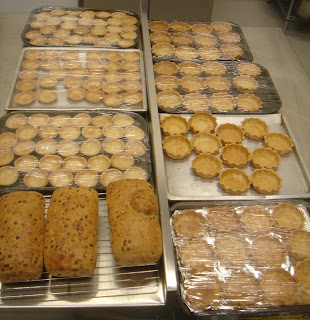 * 2008 - Also available catered only in London area
* 2008 - Also available catered only in London area We may deliver outside the Cotswolds contact us for details *
Most Highly Flavoured Gravy3:05pm on Christmas Eve, and all the deliveries are finally cooked, packed and ready to go, and then a single voice sounds out. The first verse of Once in Royal from Kings broadcast on radio 4. There’s only one month that matters in a young choristers life - and that’s December.
Composers always saved up all their tricks for their Christmas music, and the there’s the vast array of descants with which you can test your voice, reaching the highest notes possible while the congregation look on admiringly. Everyone in the choir would have their favourite carols too - for Sheila it was ‘ark the ‘erald - which always signified the beginning of Christmas for her, for Vic, it was always The Angel Gabriel - in practice he’d always change the words of the end of the chorus from ‘most highly favoured lady’ to ‘most highly flavoured gravy’ and it had us in pieces each time, and, getting to that bit when we were performing it, we‘d be knotted up inside waiting for that moment - would he say the right words? For me it was O Come All Ye Faithful. It wasn’t just that it had the highest descant, but a couple of minutes before, you’d hear the whirr of the organ being switched on and then all the stops being pulled out, and you knew - before everyone else - there was going to to be this big triumphant sound.
Years later, Christmas is still about pulling out all the stops. It begins with sourcing the best local ingredients. There’s smoked trout from
Donnington trout farm for the
starter topped at Christmas with caviar, and an old traditional family receipe for the Christmas pudding, and with coffee, handmade marshmallow with a hint of coconut from Miette in Stow on the wold. But what about the main course?
Turkey
Our Norfolk Black Turkey is free range and organically reared sourced from the
Smallholding in Chadbury. The Buckinghams have been rearing poultry for over 30 years and take care of the whole proccess themselves from the egg laying, hatching, rearing to the slaughter and preparation. They also hang their birds which gives you a much softer texture meat. Most poultry these days comes from factory production lines where the emphasis is on speed of production rather than the quality of the end result. The Buckinghams are one of only two small scale poultry farmers left in the county and have a loyal following due to the quality.
 Hazelnut stuffingMade with sausagemeat from Home Farm, hazelnuts, breadcrumbs, blackcurrants, and a little mixed spice.Caumpedene Berksire breed pork chipolatas and bacon
Hazelnut stuffingMade with sausagemeat from Home Farm, hazelnuts, breadcrumbs, blackcurrants, and a little mixed spice.Caumpedene Berksire breed pork chipolatas and bacon
Carol Webbs'
award winning Berkshire pigs produce the Cotswolds finest bacon and sausages. While Berkshire pigs are known to produce the best pork, these are left to roam the orchards eating natural food, and consequently have an almost gamey flavour the same way wild boar has. The bacon goes crispy like no other. Bacon you buy in supermarkets is pumped with water to increase the weight, but means that when you cook it all that water covers the baking tray, and the bacon steams rather than roasting/ grilling.
 Rosemary roast potatoes
Rosemary roast potatoesAs described
last weekRoast sprouts with chestnuts

Roasting is definitely the way forward with sprouts. Gone is that watery mush texture of the over-boiled sprouts that we used to have at school. Roasting keeps the flavour in, you get the caramelisation, and you can keep them quite crisp. Mixed with chestnuts and a glaze.
Creamed leeks and baby onionsMy antidote to bread sauce. By paternal grandmother would always make creamed onions with roast lamb - a yorkshire tradition - and I think they go very well with turkey too.
 Honey and thyme roast parsnip
Honey and thyme roast parsnip Most highly flavored gravy
Most highly flavored gravyOnce the turkeys have been cooked for delivery and chilled, I remove the breast and leg meat, chop the carcass and make a stock which is allowed to reduce.

The roasting juices from the roasting tin are poured off and chilled till the fat sets:

Now the fat can be removed leaving the highly flavoured tukey jus.
After that the sauce is made by caramelising
mirepoix, deglazing with red wine, adding the turkey stock and the pan roasting jus, cooking down, infusing with thyme and thickening.
The absence of cranberries
The only look-in that cranberries get is in the homemade pumpkin and cranberry bread rolls. Cranberries, being an American intervention, are not top of my list of ingredients for the traditional english feast, though due to requests I had to feature them somewhere. They make a wonderful fesive addition to the bread rolls. I prefer to use rowan and hosehip jelly to accompany turkey, made by
Dove Cottage in Broadway from berries picked from the surrounding fields.
All you need now is the mulled wine to precede it all......
For full
menu and details click hereRelated posts:Gloucestershire Echo article, Christmas 2007


 For the ones I was making today, I wanted to roll them in toasted sesame seeds, so the cucumber and avocado was rolled in the
For the ones I was making today, I wanted to roll them in toasted sesame seeds, so the cucumber and avocado was rolled in the 
 Then rolled off the edge of the mat into toasted sesame seeds (I roast these in a pan now on top of the stove where I can see them - hidden away in the oven they always get forgotten and burnt).
Then rolled off the edge of the mat into toasted sesame seeds (I roast these in a pan now on top of the stove where I can see them - hidden away in the oven they always get forgotten and burnt). Once rolled in the sesame I roll them in clingfilm to get the round shape, chill breifly and slice:
Once rolled in the sesame I roll them in clingfilm to get the round shape, chill breifly and slice: From raw ingredients to a canapé in under two hours. Served with
From raw ingredients to a canapé in under two hours. Served with  It's a long way from cans of peas.
It's a long way from cans of peas. 
 Our Norfolk Black Turkey is free range and organically reared sourced from the
Our Norfolk Black Turkey is free range and organically reared sourced from the 






 Now the fat can be removed leaving the highly flavoured tukey jus.
Now the fat can be removed leaving the highly flavoured tukey jus. The only look-in that cranberries get is in the homemade pumpkin and cranberry bread rolls. Cranberries, being an American intervention, are not top of my list of ingredients for the traditional english feast, though due to requests I had to feature them somewhere. They make a wonderful fesive addition to the bread rolls. I prefer to use rowan and hosehip jelly to accompany turkey, made by
The only look-in that cranberries get is in the homemade pumpkin and cranberry bread rolls. Cranberries, being an American intervention, are not top of my list of ingredients for the traditional english feast, though due to requests I had to feature them somewhere. They make a wonderful fesive addition to the bread rolls. I prefer to use rowan and hosehip jelly to accompany turkey, made by 
 I push the potatoes to the outside of the tray where all the heat goes - this means they cook more evenly and faster. Keep turning to prevent burning. This should take 8 - 9 minutes. If you smell burning turn the heat down.
I push the potatoes to the outside of the tray where all the heat goes - this means they cook more evenly and faster. Keep turning to prevent burning. This should take 8 - 9 minutes. If you smell burning turn the heat down.







 Although these ones were frozen for a frozen canape delivery, they were served earlier on the year for a
Although these ones were frozen for a frozen canape delivery, they were served earlier on the year for a 




 You’ve baked your tart case blind. You take it out, remove the baking beans, or in my case, flour wrapped in cling film, and brush the base and sides of the tart with beaten egg.
You’ve baked your tart case blind. You take it out, remove the baking beans, or in my case, flour wrapped in cling film, and brush the base and sides of the tart with beaten egg. As the pastry is still hot, the egg sets pretty much straight away, filling all those little holes - the ones you can see, and the ones you can’t. And if there’s a gargantuan hole you can take a piece of raw pastry, stick it down to the inside of the tart with a brush of egg and smooth it/ stick it to the cooked pastry surface. You won’t be able to tell once the thing is filled and finished that it’s had a patchwork job done on it.
As the pastry is still hot, the egg sets pretty much straight away, filling all those little holes - the ones you can see, and the ones you can’t. And if there’s a gargantuan hole you can take a piece of raw pastry, stick it down to the inside of the tart with a brush of egg and smooth it/ stick it to the cooked pastry surface. You won’t be able to tell once the thing is filled and finished that it’s had a patchwork job done on it. 











